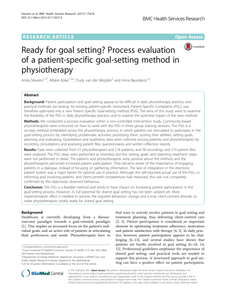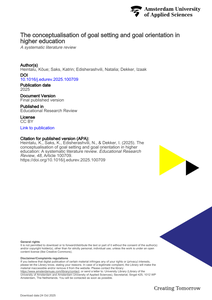Background: Patient participation and goal setting appear to be difficult in daily physiotherapy practice, and practical methods are lacking. An existing patient-specific instrument, Patient-Specific Complaints (PSC), was therefore optimized into a new Patient Specific Goal-setting method (PSG). The aims of this study were to examine the feasibility of the PSG in daily physiotherapy practice, and to explore the potential impact of the new method. Methods: We conducted a process evaluation within a non-controlled intervention study. Community-based physiotherapists were instructed on how to work with the PSG in three group training sessions. The PSG is a six-step method embedded across the physiotherapy process, in which patients are stimulated to participate in the goal-setting process by: identifying problematic activities, prioritizing them, scoring their abilities, setting goals, planning and evaluating. Quantitative and qualitative data were collected among patients and physiotherapists by recording consultations and assessing patient files, questionnaires and written reflection reports. Results: Data were collected from 51 physiotherapists and 218 patients, and 38 recordings and 219 patient files were analysed. The PSG steps were performed as intended, but the ‘setting goals’ and ‘planning treatment’ steps were not performed in detail. The patients and physiotherapists were positive about the method, and the physiotherapists perceived increased patient participation. They became aware of the importance of engaging patients in a dialogue, instead of focusing on gathering information. The lack of integration in the electronic patient system was a major barrier for optimal use in practice. Although the self-reported actual use of the PSG, i.e. informing and involving patients, and client-centred competences had improved, this was not completely confirmed by the objectively observed behaviour. Conclusion: The PSG is a feasible method and tends to have impact on increasing patient participation in the goal-setting process. However, its full potential for shared goal setting has not been utilized yet. More implementation effort is needed to achieve the required behaviour change and a truly client-centred attitude, to make physiotherapists totally ready for shared goal setting.
DOCUMENT

Abstract Study Objective To provide an overview of patients' needs concerning goal‐setting, and indications of how those needs can be met by nurses. Methods A narrative review. Pubmed and Cinahl were searched through March 1, 2020 for: patients' experiences concerning goal‐setting and the role of nursing in rehabilitation. Additional articles were found through snowballing. A total of 22 articles were reviewed on patients' experiences, and 12 on the nursing role. Results Patients need to be prepared for collaborating in goal‐setting and to receive an explanation about their part in that process. The multiplicity of disciplines may cloud patients' understanding of the process. The nurse's planning of the rehabilitation process should be aimed at resolving this issue. Goals need to be meaningful, and patients need support in attaining them. The interpretive, integrative, and consoling functions of Kirkevold's nursing role are suitable to meet these needs. Conclusions Both the literature about patients' needs regarding goal‐setting and the nursing role make clear that the way nurses work in rehabilitation can gain in clarity. Strengthening the role of nurses will improve the goal‐setting process for patients. Interprofessional collaboration, clear work procedures, continuity of care, time and trust, and the physical environment all are important to reinforce this role.
MULTIFILE

Student goals play a crucial role in both practice and theory in higher education, particularly for understanding and enhancing student motivation. However, on a conceptual level, goals are studied through separate and isolated frameworks, which complicates the ability of practitioners and researchers to combine insights from both streams of scholarship effectively. This systematic review aimed to comprehensively examine and describe the frameworks (198 studies), and conceptual distinctions and characteristics (48 studies) used in research on goal setting and goal orientation in the context of higher education since 2018. The studies selected for analysis had to discuss students’ learning process, address goal setting and goal orientation, and be published in academic journals in English. Goal-setting theory was the most frequently used for the goal-setting concept, while achievement goal theory (2 × 2 model) dominated for goal orientation. Summative content analysis revealed that goal-setting frameworks primarily emphasised the concept of the goal itself, including its structure, goal commitment, implementation intentions, and the processes leading to goal achievement. In contrast, goal orientation frameworks delved deeper into the underlying motivations driving goal pursuit, exploring related attitudes, addressing specific educational objectives and strategies, emotional factors, and the detailed standards individuals set for their outcomes. Because these theories are complementary, we propose an integrated goal setting and orientation (IGSO) theory, which can help in studying and understanding how motivation for goal pursuit is connected with the setting, monitoring and evaluation of goals.
MULTIFILE

Recycling of plastics plays an important role to reach a climate neutral industry. To come to a sustainable circular use of materials, it is important that recycled plastics can be used for comparable (or ugraded) applications as their original use. QuinLyte innovated a material that can reach this goal. SmartAgain® is a material that is obtained by recycling of high-barrier multilayer films and which maintains its properties after mechanical recycling. It opens the door for many applications, of which the production of a scoliosis brace is a typical example from the medical field. Scoliosis is a sideways curvature of the spine and wearing an orthopedic brace is the common non-invasive treatment to reduce the likelihood of spinal fusion surgery later. The traditional way to make such brace is inaccurate, messy, time- and money-consuming. Because of its nearly unlimited design freedom, 3D FDM-printing is regarded as the ultimate sustainable technique for producing such brace. From a materials point of view, SmartAgain® has the good fit with the mechanical property requirements of scoliosis braces. However, its fast crystallization rate often plays against the FDM-printing process, for example can cause poor layer-layer adhesion. Only when this problem is solved, a reliable brace which is strong, tough, and light weight could be printed via FDM-printing. Zuyd University of Applied Science has, in close collaboration with Maastricht University, built thorough knowledge on tuning crystallization kinetics with the temperature development during printing, resulting in printed products with improved layer-layer adhesion. Because of this knowledge and experience on developing materials for 3D printing, QuinLyte contacted Zuyd to develop a strategy for printing a wearable scoliosis brace of SmartAgain®. In the future a range of other tailor-made products can be envisioned. Thus, the project is in line with the GoChem-themes: raw materials from recycling, 3D printing and upcycling.
The denim industry faces many complex sustainability challenges and has been especially criticized for its polluting and hazardous production practices. Reducing resource use of water, chemicals and energy and changing denim production practices calls for collaboration between various stakeholders, including competing denim brands. There is great benefit in combining denim brands’ resources and knowledge so that commonly defined standards and benchmarks are developed and realized on a scale that matters. Collaboration however, and especially between competitors, is highly complex and prone to fail. This project brings leading denim brands together to collectively take initial steps towards improving the ecological sustainability impact of denim production, particularly by establishing measurements, benchmarks and standards for resource use (e.g. chemicals, water, energy) and creating best practices for effective collaboration. The central research question of our project is: How do denim brands effectively collaborate together to create common, industry standards on resource use and benchmarks for improved ecological sustainability in denim production? To answer this question, we will use a mixed-method, action research approach. The project’s research setting is the Amsterdam Metropolitan Area (MRA), which has a strong denim cluster and is home to many international denim brands and start-ups.
A feeling of worry, anxiety, loneliness and anticipation are commonplace in both medical and non-medical arenas such as elderly care. An innovative solution such as the ‘simple and effective’ comfyhand would offer better patient care and improved care efficiency with a high chance of long-term, economic efficiency. ComfyHand is a start-up in the healthcare sector that aims to develop sustainable products to improve patient wellbeing in healthcare settings. It does this by emulating the experience of holding a hand which gives the person comfort and support in moments where real human contact is not possible. Right now the comfyhand is in the development phase, working on several prototypes for test trials in elderly care and hospitals. In this project we want to explore the use of 3D printing for producing a comfyhand. Desired properties for the prototype include optimal heat transfer, softness, regulation of sweat, durability and sustainability. The goal of this study is to develop a prototype to test in a trial with patients within Envida, a care centre. The trial itself is out of scope of this project. This proposal focuses on researching the material of choice and the processability. Building on knowledge gained in a previous Kiem GoChem project and a Use Case (Shape3Dup) of a currently running Raak MKB project (Enlighten) on 3D printing of breast prostheses, several materials, designs and printing parameters will be tested.